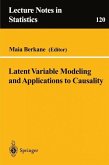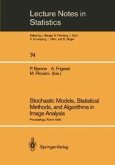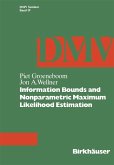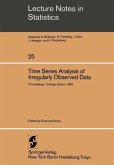Probability Models and Statistical Analyses for Ranking Data (eBook, PDF)
Redaktion: Fligner, Michael A.; Verducci, Joseph S.
72,95 €
72,95 €
inkl. MwSt.
Sofort per Download lieferbar

36 °P sammeln
72,95 €
Als Download kaufen

72,95 €
inkl. MwSt.
Sofort per Download lieferbar

36 °P sammeln
Jetzt verschenken
Alle Infos zum eBook verschenken
72,95 €
inkl. MwSt.
Sofort per Download lieferbar
Alle Infos zum eBook verschenken

36 °P sammeln
Probability Models and Statistical Analyses for Ranking Data (eBook, PDF)
Redaktion: Fligner, Michael A.; Verducci, Joseph S.
- Format: PDF
- Merkliste
- Auf die Merkliste
- Bewerten Bewerten
- Teilen
- Produkt teilen
- Produkterinnerung
- Produkterinnerung

Bitte loggen Sie sich zunächst in Ihr Kundenkonto ein oder registrieren Sie sich bei
bücher.de, um das eBook-Abo tolino select nutzen zu können.
Hier können Sie sich einloggen
Hier können Sie sich einloggen
Sie sind bereits eingeloggt. Klicken Sie auf 2. tolino select Abo, um fortzufahren.

Bitte loggen Sie sich zunächst in Ihr Kundenkonto ein oder registrieren Sie sich bei bücher.de, um das eBook-Abo tolino select nutzen zu können.
This book of edited papers provides a wide-ranging survey of the use of probability models for ranking data and it introduces new methods for the statistical analysis of ranking data. The contributors are drawn from a variety of fields including psychology, sociology, and the health sciences as well as statistics. Consequently, many researchers whose work involves the study of ranked data will find much of practical interest here.
- Geräte: PC
- ohne Kopierschutz
- eBook Hilfe
- Größe: 26.77MB
Andere Kunden interessierten sich auch für
![Computing Science and Statistics (eBook, PDF) Computing Science and Statistics (eBook, PDF)]() Computing Science and Statistics (eBook, PDF)72,95 €
Computing Science and Statistics (eBook, PDF)72,95 €![Latent Variable Modeling and Applications to Causality (eBook, PDF) Latent Variable Modeling and Applications to Causality (eBook, PDF)]() Latent Variable Modeling and Applications to Causality (eBook, PDF)72,95 €
Latent Variable Modeling and Applications to Causality (eBook, PDF)72,95 €![Stochastic Models, Statistical Methods, and Algorithms in Image Analysis (eBook, PDF) Stochastic Models, Statistical Methods, and Algorithms in Image Analysis (eBook, PDF)]() Stochastic Models, Statistical Methods, and Algorithms in Image Analysis (eBook, PDF)72,95 €
Stochastic Models, Statistical Methods, and Algorithms in Image Analysis (eBook, PDF)72,95 €![Advances in Ranking and Selection, Multiple Comparisons, and Reliability (eBook, PDF) Advances in Ranking and Selection, Multiple Comparisons, and Reliability (eBook, PDF)]() Advances in Ranking and Selection, Multiple Comparisons, and Reliability (eBook, PDF)112,95 €
Advances in Ranking and Selection, Multiple Comparisons, and Reliability (eBook, PDF)112,95 €![Information Bounds and Nonparametric Maximum Likelihood Estimation (eBook, PDF) Information Bounds and Nonparametric Maximum Likelihood Estimation (eBook, PDF)]() P. GroeneboomInformation Bounds and Nonparametric Maximum Likelihood Estimation (eBook, PDF)40,95 €
P. GroeneboomInformation Bounds and Nonparametric Maximum Likelihood Estimation (eBook, PDF)40,95 €![Parametric and Semiparametric Models with Applications to Reliability, Survival Analysis, and Quality of Life (eBook, PDF) Parametric and Semiparametric Models with Applications to Reliability, Survival Analysis, and Quality of Life (eBook, PDF)]() Parametric and Semiparametric Models with Applications to Reliability, Survival Analysis, and Quality of Life (eBook, PDF)80,95 €
Parametric and Semiparametric Models with Applications to Reliability, Survival Analysis, and Quality of Life (eBook, PDF)80,95 €![Time Series Analysis of Irregularly Observed Data (eBook, PDF) Time Series Analysis of Irregularly Observed Data (eBook, PDF)]() Time Series Analysis of Irregularly Observed Data (eBook, PDF)72,95 €
Time Series Analysis of Irregularly Observed Data (eBook, PDF)72,95 €-
-
-
This book of edited papers provides a wide-ranging survey of the use of probability models for ranking data and it introduces new methods for the statistical analysis of ranking data. The contributors are drawn from a variety of fields including psychology, sociology, and the health sciences as well as statistics. Consequently, many researchers whose work involves the study of ranked data will find much of practical interest here.
Dieser Download kann aus rechtlichen Gründen nur mit Rechnungsadresse in A, B, BG, CY, CZ, D, DK, EW, E, FIN, F, GR, HR, H, IRL, I, LT, L, LR, M, NL, PL, P, R, S, SLO, SK ausgeliefert werden.
Produktdetails
- Produktdetails
- Verlag: Springer US
- Seitenzahl: 306
- Erscheinungstermin: 6. Dezember 2012
- Englisch
- ISBN-13: 9781461227380
- Artikelnr.: 44052815
- Verlag: Springer US
- Seitenzahl: 306
- Erscheinungstermin: 6. Dezember 2012
- Englisch
- ISBN-13: 9781461227380
- Artikelnr.: 44052815
- Herstellerkennzeichnung Die Herstellerinformationen sind derzeit nicht verfügbar.
1 Ranking Models with Item Covariates.- 1.1 Introduction.- 1.2 Basic Ranking Models and Their Parameters.- 1.3 Ranking Models with Covariates.- 1.4 Estimation.- 1.5 Example.- 1.6 Discussion.- 1.7 Appendix.- 1.8 References.- 2 Nonparametric Methods of Ranking from Paired Comparisons.- 2.1 Introduction and Literature Review.- 2.2 The Proposed Method of Scoring.- 2.3 Distribution Theory and Tests of Significance for ??ij = pij.- 2.4 Ranking Methods.- 2.5 Numerical Example.- 2.6 References.- 3 On the Babington Smith Class of Models for Rankings.- 3.1 Introduction.- 3.2 Alternative Parametrizations and Related Models.- 3.3 Stochastic Transitivity and Item Preference.- 3.4 Examples and Data Analysis.- 3.5 References.- 4 Latent Structure Models for Ranking Data.- 4.1 Introduction.- 4.2 Latent Class Analyses Based on the Bradley-Terry-Luce Model.- 4.3 Latent Class Analyses Based on a Quasi-independence Model.- 4.4 Models that Allow for Association Between Choices within the Classes.- 4.5 References.- 5 Modelling and Analysing Paired Ranking Data.- 5.1 Introduction.- 5.2 Two Models.- 5.3 Estimation and Hypothesis Testing.- 5.4 Analysis of Simulated Data Sets.- 5.5 Analysis of Rogers Data.- 5.6 References.- 6 Maximum Likelihood Estimation in Mallows's Model Using Partially Ranked Data.- 6.1 Introduction.- 6.2 Notation.- 6.3 Maximum Likelihood Estimation Using the EM Algorithm.- 6.4 Example.- 6.5 Discussion.- 6.6 References.- 7 Extensions of Mallows' ? Model.- 7.1 Introduction.- 7.2 The General Model.- 7.3 Ties, Partial Rankings.- 7.4 Example: Word Association.- 7.5 Example: APA Voting.- 7.6 Example: ANOVA.- 7.7 Discussion of Contrasts.- 7.8 Appendix.- 7.9 References.- 8 Rank Correlations and the Analysis of Rank-Based Experimental Designs.- 8.1 Introduction.- 8.2 DistanceBased Measures of Correlation.- 8.3 The Problem of m Rankings.- 8.4 The Two Sample Problem.- 8.5 The Problem of m Rankings for a Balanced Incomplete Block Design.- 8.6 The Problem of m Rankings for Cyclic Designs.- 8.7 Measuring Correlation Between Incomplete Rankings.- 8.8 References.- 9 Applications of Thurstonian Models to Ranking Data.- 9.1 Introduction.- 9.2 The Ranking Model.- 9.3 Modeling ?.- 9.4 Subpopulations.- 9.5 Model Estimation and Tests.- 9.6 Applications.- 9.7 Discussion.- 9.8 References.- 10 Probability Models on Rankings and the Electoral Process.- 10.1 Introduction.- 10.2 Electoral Systems.- 10.3 Models for Permutations.- 10.4 The American Psychological Association Election.- 10.5 Simulation Results.- 10.6 Conclusions and Summary.- 10.7 Acknowledgements.- 10.8 References.- 11 Permutations and Regression Models.- 11.1 Introduction.- 11.2 Models for Random Permutations.- 11.3 Sufficient Statistics and Log-linear Models.- 11.4 Conclusions.- 11.5 References.- 12 Aggregation Theorems and the Combination of Probabilistic Rank Orders.- 12.1 Introduction.- 12.2 Notation and Basic Aggregation Theorems.- 12.3 Specific Multidimensional Ranking and Subset Selection Models and Their Properties.- 12.4 Multidimensional Random Variable Models.- 12.5 Conclusion.- 12.6 References.- 13 A Nonparametric Distance Model for Unidimensional Unfolding.- 13.1 Introduction.- 13.2 Social Choice Theory.- 13.3 Distance Measures for Rankings.- 13.4 Strongly Unimodal Distance Models for Rankings.- 13.5 Generalization of Coombs' and Goodman's Conditions.- 13.6 Equal Results for ML or MNI Criterion.- 13.7 Unfolding and Social Choice Theory: Illustrations.- 13.8 Discussion.- 13.9 References.- Miscellanea.- Models on Spheres and Models for Permutations.- Complete Consensus and OrderIndependence: Relating Ranking and Choice.- Ranking From Paired Comparisons by Minimizing Inconsistency.- Graphical Techniques for Ranked Data.- Matched Pairs and Ranked Data.
1 Ranking Models with Item Covariates.- 1.1 Introduction.- 1.2 Basic Ranking Models and Their Parameters.- 1.3 Ranking Models with Covariates.- 1.4 Estimation.- 1.5 Example.- 1.6 Discussion.- 1.7 Appendix.- 1.8 References.- 2 Nonparametric Methods of Ranking from Paired Comparisons.- 2.1 Introduction and Literature Review.- 2.2 The Proposed Method of Scoring.- 2.3 Distribution Theory and Tests of Significance for ??ij = pij.- 2.4 Ranking Methods.- 2.5 Numerical Example.- 2.6 References.- 3 On the Babington Smith Class of Models for Rankings.- 3.1 Introduction.- 3.2 Alternative Parametrizations and Related Models.- 3.3 Stochastic Transitivity and Item Preference.- 3.4 Examples and Data Analysis.- 3.5 References.- 4 Latent Structure Models for Ranking Data.- 4.1 Introduction.- 4.2 Latent Class Analyses Based on the Bradley-Terry-Luce Model.- 4.3 Latent Class Analyses Based on a Quasi-independence Model.- 4.4 Models that Allow for Association Between Choices within the Classes.- 4.5 References.- 5 Modelling and Analysing Paired Ranking Data.- 5.1 Introduction.- 5.2 Two Models.- 5.3 Estimation and Hypothesis Testing.- 5.4 Analysis of Simulated Data Sets.- 5.5 Analysis of Rogers Data.- 5.6 References.- 6 Maximum Likelihood Estimation in Mallows's Model Using Partially Ranked Data.- 6.1 Introduction.- 6.2 Notation.- 6.3 Maximum Likelihood Estimation Using the EM Algorithm.- 6.4 Example.- 6.5 Discussion.- 6.6 References.- 7 Extensions of Mallows' ? Model.- 7.1 Introduction.- 7.2 The General Model.- 7.3 Ties, Partial Rankings.- 7.4 Example: Word Association.- 7.5 Example: APA Voting.- 7.6 Example: ANOVA.- 7.7 Discussion of Contrasts.- 7.8 Appendix.- 7.9 References.- 8 Rank Correlations and the Analysis of Rank-Based Experimental Designs.- 8.1 Introduction.- 8.2 DistanceBased Measures of Correlation.- 8.3 The Problem of m Rankings.- 8.4 The Two Sample Problem.- 8.5 The Problem of m Rankings for a Balanced Incomplete Block Design.- 8.6 The Problem of m Rankings for Cyclic Designs.- 8.7 Measuring Correlation Between Incomplete Rankings.- 8.8 References.- 9 Applications of Thurstonian Models to Ranking Data.- 9.1 Introduction.- 9.2 The Ranking Model.- 9.3 Modeling ?.- 9.4 Subpopulations.- 9.5 Model Estimation and Tests.- 9.6 Applications.- 9.7 Discussion.- 9.8 References.- 10 Probability Models on Rankings and the Electoral Process.- 10.1 Introduction.- 10.2 Electoral Systems.- 10.3 Models for Permutations.- 10.4 The American Psychological Association Election.- 10.5 Simulation Results.- 10.6 Conclusions and Summary.- 10.7 Acknowledgements.- 10.8 References.- 11 Permutations and Regression Models.- 11.1 Introduction.- 11.2 Models for Random Permutations.- 11.3 Sufficient Statistics and Log-linear Models.- 11.4 Conclusions.- 11.5 References.- 12 Aggregation Theorems and the Combination of Probabilistic Rank Orders.- 12.1 Introduction.- 12.2 Notation and Basic Aggregation Theorems.- 12.3 Specific Multidimensional Ranking and Subset Selection Models and Their Properties.- 12.4 Multidimensional Random Variable Models.- 12.5 Conclusion.- 12.6 References.- 13 A Nonparametric Distance Model for Unidimensional Unfolding.- 13.1 Introduction.- 13.2 Social Choice Theory.- 13.3 Distance Measures for Rankings.- 13.4 Strongly Unimodal Distance Models for Rankings.- 13.5 Generalization of Coombs' and Goodman's Conditions.- 13.6 Equal Results for ML or MNI Criterion.- 13.7 Unfolding and Social Choice Theory: Illustrations.- 13.8 Discussion.- 13.9 References.- Miscellanea.- Models on Spheres and Models for Permutations.- Complete Consensus and OrderIndependence: Relating Ranking and Choice.- Ranking From Paired Comparisons by Minimizing Inconsistency.- Graphical Techniques for Ranked Data.- Matched Pairs and Ranked Data.







